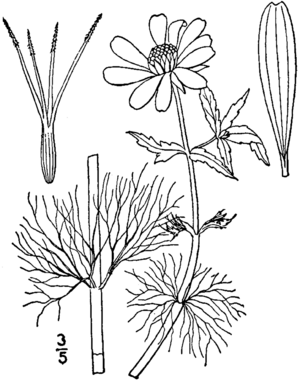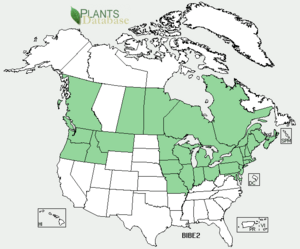Beck's water-marigold facts for kids
Quick facts for kids Beck's water-marigold |
|
|---|---|
 |
|
| 1913 illustration | |
| Scientific classification | |
| Genus: |
Bidens
|
| Species: |
beckii
|
 |
|
| Range within North America | |
| Synonyms | |
|
Megalodonta beckii (Torr. ex Spreng.) Greene |
|
The Bidens beckii, also known as Beck's water-marigold or simply water marigold, is a beautiful species of flowering plant. It belongs to the daisy family, which is a very large group of plants! You can find this plant growing naturally in Canada and the northern parts of the United States.
Contents
What Does Beck's Water-Marigold Look Like?
Beck's water-marigold is a perennial plant. This means it lives for more than two years. It can grow quite tall, sometimes up to 200 centimeters (about 80 inches)!
How It Grows in Water
This plant loves water. It often grows out of still or slow-moving water, like ponds or quiet streams. The parts of the plant that are underwater have very thin, finely cut leaves. They look a bit like threads.
Stems and Leaves Above Water
The stem usually rises about 15 centimeters above the water. The leaves on the stem above the water are different. They are simple, meaning they are not divided into smaller leaflets. They grow in pairs, one on each side of the stem (this is called "opposite arrangement"). These leaves are shaped like a spear (lanceolate) or an egg (ovate). They also have jagged edges, like a saw (serrated). They attach directly to the stem without a leaf stalk (petiole).
Its Bright Yellow Flowers
In late summer, Bidens beckii produces many bright yellow flower heads. These flower heads are like mini-bouquets. Each one has 10 to 30 tiny flowers in the center, called disc florets. Around these, there are 8 larger, petal-like flowers called ray florets.
The flowers grow one by one at the end of the stem. Each flower is about 2 to 2.5 centimeters wide. Just below the flower, there are 5 to 8 small, smooth leaf-like parts called bracts. These bracts are about half as long as the petals.


